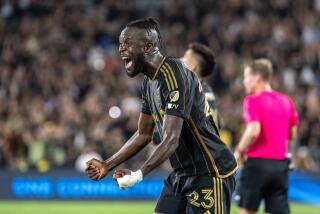Climbing Charts Again
- Share via
No one ever mistook Erik Kramer for a prototype quarterback.
“Not quite big enough,” a former coach says. “Not quite fast enough.”
For every good season he has played, there has been a shaky one. Seems that every summer, another quarterback comes to camp looking better on paper.
The 6-foot-1, 200-pound Kramer invariably returns to basics, studying game film, trimming any unnecessary motion from his drop back. He calls it: “Quietly going about my business.”
This summer is no different. Having missed most of last season with a herniated disk, Kramer returns to the Chicago Bears to find his starting spot occupied by the newly acquired Rick Mirer. At 32, he again has been slotted at backup.
But just two games into the exhibition schedule, with Chicago playing Miami on Sunday night, Kramer has outshone Mirer. And suddenly Coach Dave Wannstedt is using words like “if” when discussing his quarterback situation.
Business as usual for Kramer, who has made a career of improbable comebacks.
“I’ve been through enough of these situations that it doesn’t bother me,” he said from training camp in Platteville, Wis. “I’ve been underestimated a lot.”
It all started in 1981, when he failed to start at St. Genevieve High. So great was his desire, Kramer and his father moved from Canoga Park to an apartment in Burbank so he could try for the top spot at Burroughs his senior year.
“We already had an all-star quarterback,” said Bob Dunivant, a Burroughs assistant at the time. “But Erik definitely had a great arm.”
The coaches argued over who to start. In the end, they chose the returning quarterback and asked Kramer to play safety. The following season, he threw in practice for the coaches at Valley College but was told: “No thanks.”
At that point, there was virtually no reason to believe that he would ever play quarterback anywhere.
Yet he still saw a chance. He worked tirelessly at the little things that more talented players might overlook. Like practicing a nimble crossover step when he dropped back. Or stopping and setting up in perfect balance.
“He was just a very determined kid,” Cal State Northridge Coach Jim Fenwick said. “There wasn’t a lot of wasted movement. He was just so darn efficient.”
Fenwick can take credit for being the first coach to give Kramer a shot. In 1984, while coaching at Pierce, he made Kramer the starting quarterback on a team that went 10-1 and reached the Potato Bowl.
On the strength of that season, Kramer was recruited by North Carolina State and quickly proved to be the best passer the school had seen. In his senior season, he was honored as the 1986 Atlantic Coast Conference player of the year.
It seemed that his playing credentials were finally secure. Then came the National Football League draft.
Fenwick, who has remained close to Kramer, figures that his former student suffered from a problem of perception.
“Coaches will say, ‘I want a 6-4 quarterback who can do this and do that,’ ” Fenwick said. “Erik doesn’t fit that mold. So coaches keep looking for someone who is a little bit bigger or a little bit better in some way.”
When the 1987 draft came around and Kramer did not get picked, Fenwick said it was “a dose of reality.”
By that point, however, Kramer was way beyond reality. He was confident that he could play in the NFL.
Confident even after the New Orleans Saints cut him in training camp.
Confident even after the Atlanta Falcons signed him for the 1987 strike and cut him the following summer.
Confident even after two miserable seasons with the Calgary Stampeders in the Canadian Football League, during which he threw a forgettable five touchdown passes and 13 interceptions and injured his knee.
“I still thought I could play,” he said.
So, in 1990, he called the Detroit Lions and wrangled an invitation to camp. He injured his shoulder in an exhibition game but the team had seen enough to keep him on injured reserve.
The following season, when Rodney Peete went down, Kramer beat Andre Ware for the starting role.
“That was a fun time,” he said. “I got to play a lot and we got really hot.”
Detroit won its division and played the Dallas Cowboys in the first round of the playoffs. Kramer passed for 341 yards and three touchdowns in a 38-6 victory. He was chosen NFC offensive player of the week.
Even after losing to the Washington Redskins in the conference championship game the following week, Kramer felt good.
“The eyes of the country were on us,” he said. “I proved myself.”
That satisfaction had to sustain him through a roller-coaster ride over the following seasons.
Kramer spent much of 1992 and 1993 on the bench behind a healthy Peete. He signed an $8.1 million free-agent contract with Chicago the following year but suffered another injury and was benched in favor of Steve Walsh.
In 1995, he returned to throw for 3,838 yards and 29 touchdowns, by far his best season in the NFL. But last year he played only four games before suffering the herniated disk in his neck.
If anything, his career has benefited from the fact that he has never played on a with a top-notch quarterback. With the likes of Ware and Walsh above him on the depth chart, there was always a chance of playing.
Now comes Mirer, a former first-round pick who is seeking redemption after four disappointing seasons with the Seattle Seahawks.
Mirer looked shaky during the Bears’ exhibition opener against the Pittsburgh Steelers. Kramer, on the other hand, stepped in and passed to Haywood Jeffires for 35 yards on his first play.
“Erik was pretty sharp,” Wannstedt told reporters afterward.
A Chicago columnist wrote: “Bring in the backup!”
Kramer is keeping quiet about the whole thing, professing that he doesn’t want to cause a stir. But the very next moment, he said: “I know that if I hang around and do the things that have made me successful, things are going to work out.”
There is a quiet confidence in his voice.
“It’s like when you throw a couple interceptions and the fans start booing,” he said. “You can’t get panicky.”
Spoken like a true survivor.
More to Read
Go beyond the scoreboard
Get the latest on L.A.'s teams in the daily Sports Report newsletter.
You may occasionally receive promotional content from the Los Angeles Times.











